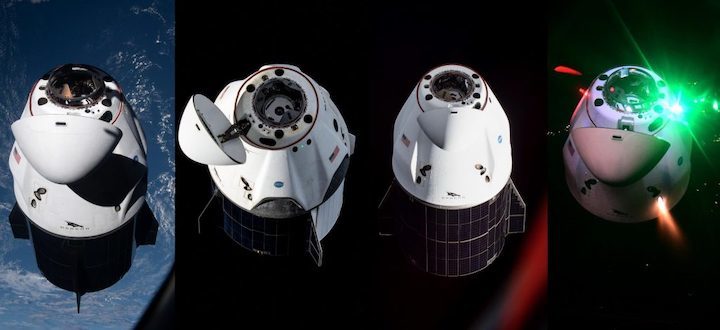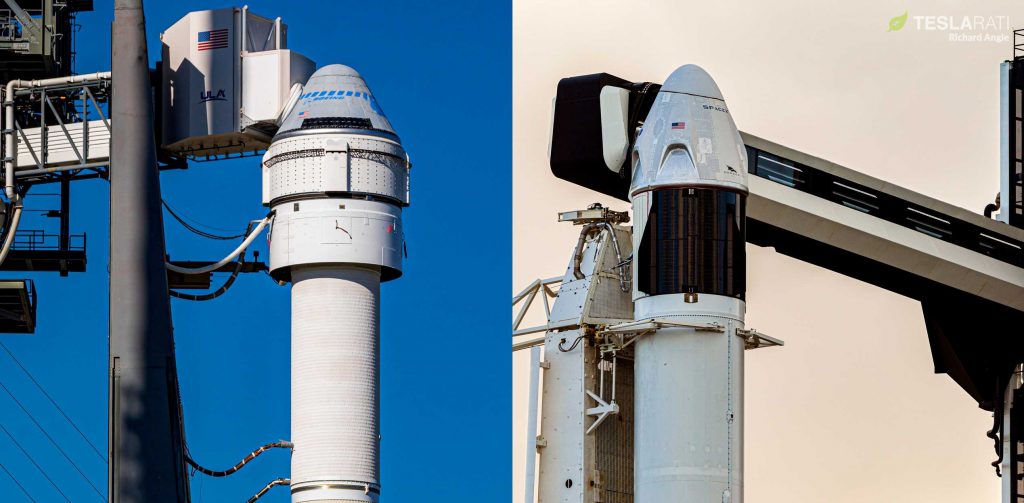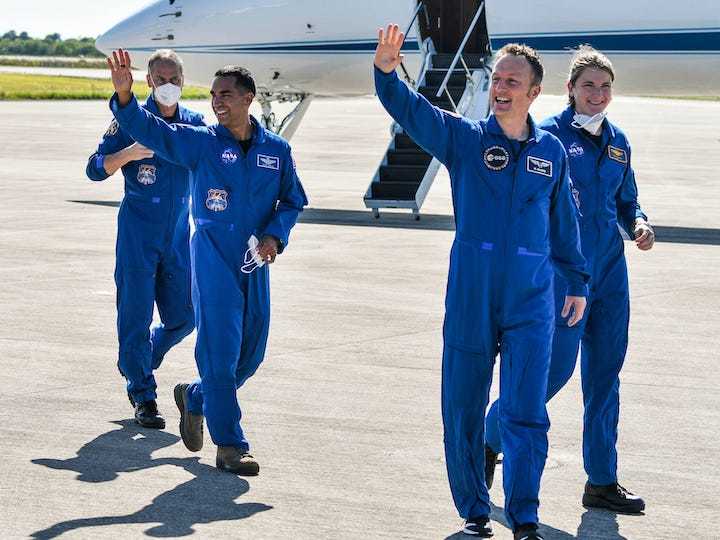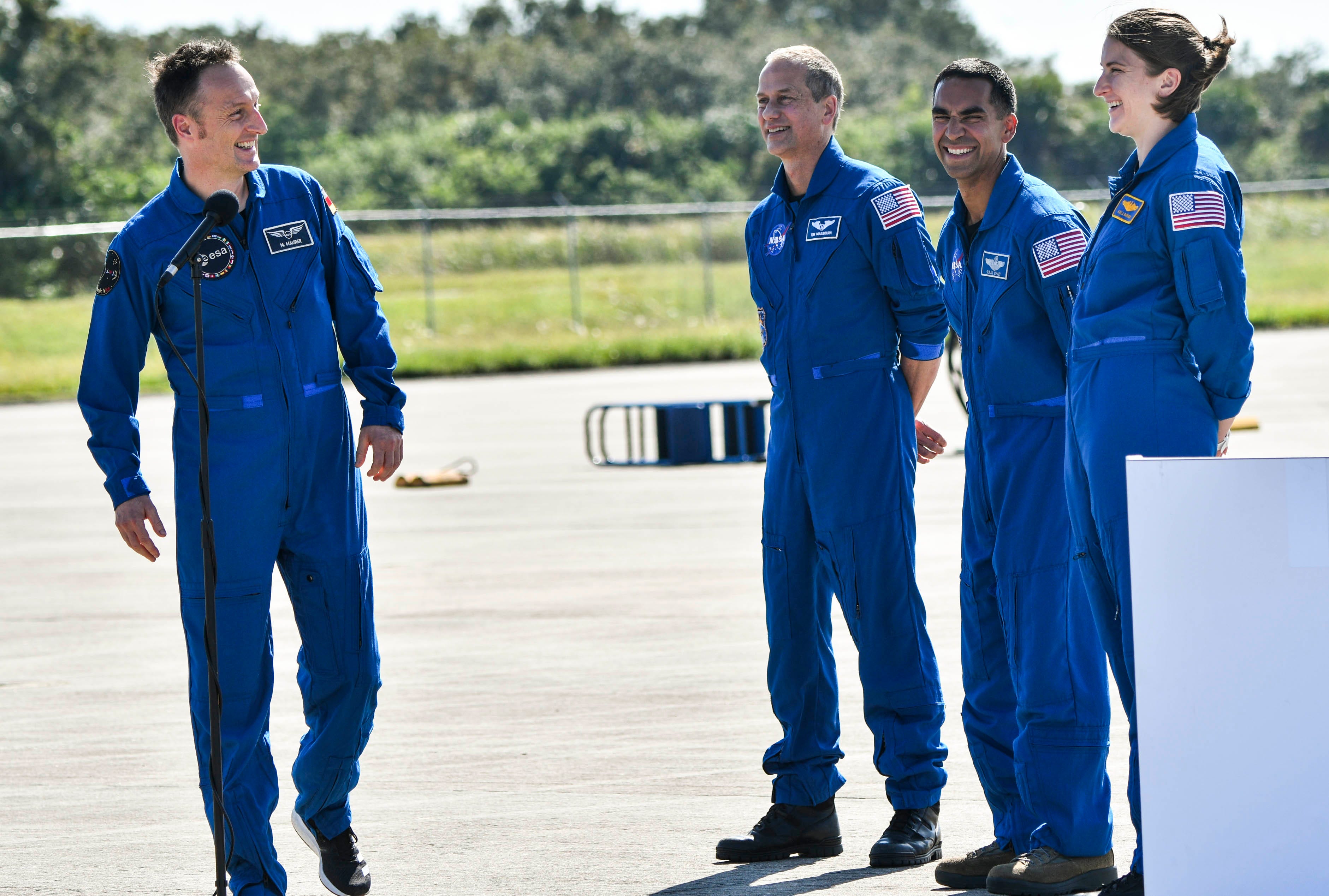18.10.2021
SpaceX will debut new Dragon capsule for upcoming crew launch

SpaceX will debut a new Crew Dragon capsule, the company's third to carry astronauts, for the Crew 3 mission to the International Space Station on Oct. 30, Elon Musk's company said Wednesday.
"Crew 3 will be flying on a new Dragon spacecraft and it's really exciting to introduce another Crew Dragon to our fleet," Sarah Walker, SpaceX director of Dragon mission management, said in a news conference broadcast from Johnson Space Center in Houston.
"We've got another [Crew Dragon] in the production line ... that should be ready in the spring to support more human spaceflight missions," Walker said.
The mission will carry commander Raja Chari, 44, and pilot Thomas Mashburn, 61, both NASA astronauts, and mission specialists Matthias Maurer, 51, of the European Space Agency and Kayla Barron, 34, of NASA. It will be the first trip to space for Chari, Maurer and Barron.
The flight will be the fifth crewed mission for SpaceX, including a demonstration mission that carried two astronauts to the space station in 2020. The Inspiration-4 mission that flew in orbit for three days with four civilians inside returned to Earth on Sept. 20.
SpaceX hasn't made many changes to the new Crew Dragon capsule, Walker said, but it did fix a loose connection in the waste disposal system
"And then we did develop a small design improvement ... to make the system even more robust for flying these vehicles multiple times," Walker said, without specifying.
NASA learned more about the Crew Dragon's systems, especially life support, from the Inspiration-4 mission, said Steve Stich, NASA's Commercial Crew Program manager.
"In terms of life support ... we learned the carbon dioxide scrubbing system [did] a really good job," Stich said. "I think we learned that we have a little more capability and robustness in the system than we expected."
The mission is important to keep up science and activity levels on the space station, as NASA and Congress prepare to extend its official lifespan from to 2030 from 2028, said Kathy Lueders, NASA associate administrator for space operations.
"These missions allow us to do more science, to buy down our exploration risks and push the bounds of technology, while continuing to establish our key international partner relationships," Lueders said.
NASA has scheduled another press conference with the astronauts Thursday afternoon.
Quelle: SD
----
Update: 22.10.2021
.
SpaceX’s next Crew Dragon astronaut mission settles on Halloween launch
After initially moving forward 24 hours from October 31st to October 30th, SpaceX’s next Crew Dragon astronaut mission has slipped back to its initial Halloween launch date.
Again scheduled to lift off around 2:21 am EDT (UTC-4) on Halloween morning, SpaceX’s Falcon 9 rocket and Crew Dragon spacecraft are on track to support their third operational NASA astronaut launch since November 2020. Known as Crew-3, the mission will carry NASA astronauts Thomas Marshburn, Raja Chari, Kayla Barron, and ESA (European Space Agency) astronaut Matthias Maurer to the International Space Station (ISS). A few weeks later, Crew-3 will take over command of the US ISS segment, allowing Crew Dragon Crew-2 astronauts Shane Kimbrough, Megan McArthur, Akihiko Hoshide, and Thomas Pesquet to return to Earth after some six and a half months in orbit.
Unlike Crew-2, which became the first astronaut launch in history to use a flight-proven orbital space capsule in April 2021, Crew-3 astronauts will head to the ISS inside a new capsule. Likely to be Dragon 2 capsule #10 (C210), SpaceX says it will be the first of at least two new Crew Dragons scheduled to join the company’s fleet of reusable crew capsules between now and mid-2022. Each Dragon 2 capsule (Crew and Cargo variants) is designed and rated to complete at least five orbital spaceflights before retirement and there’s a good chance that that five-flight limit can be expanded if needed.

New Dragon aside, Crew-3 will still be the second time professional astronauts launch on a flight-proven liquid rocket booster – SpaceX’s Falcon 9. Between Crew-2 and Crew-3, SpaceX also launched four private, rookie astronauts – a world first – on a flight-proven Dragon and Falcon 9 booster, further strengthening the pair’s pedigree as the first privately-developed, reusable, human-rated rocket and spacecraft. Crew-3 will be Falcon 9 booster B1067’s second Dragon launch and second launch overall after a successful Cargo Dragon launch debut in June 2021.
When the Commercial Crew Program culminated in NASA awarding SpaceX $2.6B to develop Crew Dragon and Boeing $4.2B to develop Starliner, the goal was always to field two redundant crew transfer vehicles and then alternate launches of those vehicles every six or so months. However, despite charging NASA almost two-thirds more than SpaceX to provide the exact same service, Boeing’s Starliner program has run into numerous hardware and software issues over the last two years, causing major delays.
As a result, more than 31 months after a SpaceX Crew Dragon aced its first uncrewed test flight to and from the space station and almost 18 months after Dragon launched its first two astronauts, Boeing’s Starliner has yet to complete a successful orbital test flight and yet to launch a single astronaut. Recently, Boeing’s second uncrewed test flight – required after Starliner suffered near-catastrophic software failures on its first attempt – has been delayed by chronic valve issues from July or August 2021 to May 2022. NASA has also begun shuffling astronauts originally scheduled to launch on Starliner’s Crew-1 equivalent mission to Crew Dragon’s August 2022 Crew-5 mission.

Starliner’s first crewed flight test (CFT) is entirely dependent upon the near-flawless success of OFT-2 – far from guaranteed. Per Boeing’s senior Starliner program manager, the current best-case scenario would see the company launch CFT six months after OFT-2 – no earlier than November 2022 if OFT-2 flies next May. In other words, based on the program’s history of chronic delays, it’s more likely than not that Starliner won’t fly crew until early 2023. Given Crew-5’s August 2022 launch target, Boeing would have to ace its crewed flight test, pass extensive NASA post-flight reviews, and achieve NASA certification in just a month or two for SpaceX and Crew Dragon to not end up flying Crew-6 in February or March 2023.
Put simply, Boeing has gotten itself into a situation where it would take a minor miracle for Starliner to complete a single operational launch before SpaceX launches all six NASA Crew Dragon missions currently on contract – and back to back, no less. Crew-3 will mark the halfway point to a milestone that would have been unfathomable just a few years ago.
Quelle: TESLARATI
+++
Coverage Set for NASA’s SpaceX Crew-3 Briefings, Events, Broadcasts
NASA will provide coverage of the upcoming prelaunch and launch activities for the agency’s SpaceX Crew-3 mission with astronauts to the International Space Station. This is the third crew rotation mission with astronauts on the SpaceX Crew Dragon spacecraft and the fourth flight with astronauts, including the Demo-2 test flight, as part of the agency’s Commercial Crew Program.
The launch is targeted for 2:21 a.m. EDT Sunday, Oct. 31, on a SpaceX Falcon 9 rocket from Launch Complex 39A at NASA’s Kennedy Space Center in Florida. The Crew Dragon Endurance is scheduled to dock to the space station at 12:10 a.m. Monday, Nov. 1. Prelaunch activities, launch, and docking will air live on NASA Television, the NASA app, and the agency’s website.
The Crew-3 flight will carry NASA astronauts Raja Chari, mission commander; Tom Marshburn, pilot; and Kayla Barron, mission specialist; as well as ESA (European Space Agency) astronaut Matthias Maurer, who will serve as a mission specialist, to the space station for a six-month science mission.
The deadline has passed for media accreditation for in-person coverage of this launch. More information about media accreditation is available by emailing: ksc-media-accreditat@mail.nasa.gov.
All media participation in the following news conferences will be remote except where specifically listed below, and only a limited number of media will be accommodated at Kennedy due to the ongoing coronavirus (COVID-19) pandemic. Please note that the Kennedy Press Site facilities will remain closed throughout these events for the protection of Kennedy employees and journalists, except for a limited number of media who will receive confirmation in writing in the coming days.
NASA’s SpaceX Crew-3 mission coverage is as follows (all times Eastern):
Monday, Oct. 25
7 p.m. (approximately) – Flight Readiness Review (FRR) Media Teleconference at Kennedy (no earlier than one hour after completion of the FRR) with the following participants:
- Kathryn Lueders, associate administrator, Space Operations Mission Directorate, NASA Headquarters
- Steve Stich, manager, NASA Commercial Crew Program, Kennedy
- Joel Montalbano, manager, International Space Station, NASA’s Johnson Space Center
- Holly Ridings, chief flight director, Flight Operations Directorate, Johnson
- William Gerstenmaier, vice president, Build and Flight Reliability, SpaceX
- Frank de Winne, program manager, International Space Station, ESA
- Junichi Sakai, manager, International Space Station, JAXA
Media may ask questions via phone only. For the dial-in number and passcode, please contact the Kennedy newsroom no later than 4 p.m. Monday, Oct. 25, at: ksc-newsroom@mail.nasa.gov .
Tuesday, Oct. 26
1:30 p.m. (approximately) – Crew Arrival Media Event at Kennedy with the following participants (limited, previously confirmed in-person media only):
- Bob Cabana, NASA associate administrator
- Janet Petro, director, NASA’s Kennedy Space Center
- Frank de Winne, program manager, International Space Station, ESA
- NASA astronaut Raja Chari
- NASA astronaut Tom Marshburn
- NASA astronaut Kayla Barron
- ESA astronaut Matthias Maurer
No teleconference option is available for this event.
Wednesday, Oct. 27
7:45 a.m. – Virtual Crew Media Engagement at Kennedy with Crew-3 astronauts:
- NASA astronaut Raja Chari
- NASA astronaut Tom Marshburn
- NASA astronaut Kayla Barron
- ESA astronaut Matthias Maurer
Media may ask questions via phone only. For the dial-in number and passcode, please contact the Kennedy newsroom no later than 7 a.m. Wednesday, Oct. 27, at: ksc-newsroom@mail.nasa.gov.
Thursday, Oct. 28
1 p.m. – Science Media Teleconference to discuss investigations the Crew-3 crew will support during their mission with the following participants:
- David Brady, associate program scientist for the International Space Station Program at Johnson, will provide an introduction to the research and technology aboard the Crew Dragon spacecraft.
- Dr. Yun-Xing Wang, senior investigator in the Structural Biophysics Laboratory at the National Cancer Institute, and Dr. Jason R. Stagno, staff scientist in the Structural Biophysics Laboratory at the National Cancer Institute. Wang and Stagno will discuss the Uniform Protein Crystal Growth experiment that aims to grow near perfect microcrystals in microgravity, which will be immediately analyzed by a powerful atomic imager on their return to Earth alongside the Crew-2 astronauts.
- Dr. Grace Douglas, lead scientist for NASA’s Advanced Food Technology research effort, who will discuss the Food Physiologyexperiment. This investigation studies the impacts of an enhanced spaceflight diet on astronaut health.
- Dr. Hector Guiterrez, professor of mechanical and aerospace engineering at the Florida Institute of Technology, who will discuss the Smartphone Video Guidance Sensor (SVGS) that will test a set of LED beacons with which the Astrobee free-flying robots will interact during formation flight maneuvers.
- A representative from the Standard Measures investigation, which collects a set of core measurements related to many human spaceflight risks from astronauts before, during, and after long-duration missions.
Media may ask questions via phone only. For the dial-in number and passcode, please contact Stephanie Schierholz no later than 10 a.m. Thursday, Oct. 28, at: stephanie.schierholz@nasa.gov.
Friday, Oct. 29
12 p.m. – NASA Administrator Media Briefing on NASA TV with the following participants:
- Bill Nelson, NASA administrator
- Pam Melroy, NASA deputy administrator
- Bob Cabana, NASA associate administrator
- Kathryn Lueders, associate administrator, Space Operations Mission Directorate, NASA Headquarters
- Janet Petro, director, NASA’s Kennedy Space Center
- Woody Hoburg, NASA astronaut
Media may ask questions via phone only. For the dial-in number and passcode, please contact the Kennedy newsroom no later than 11 a.m. Friday, Oct. 29, at: ksc-newsroom@mail.nasa.gov
10 p.m. – Prelaunch News Conference at Kennedy (no earlier than one hour after completion of the Launch Readiness Review) with the following participants:
- Steve Stich, manager, Commercial Crew Program, Kennedy
- Joel Montalbano, manager, International Space Station, Johnson
- Jennifer Buchli, deputy chief scientist, International Space Station Program, Johnson
- Holly Ridings, chief flight director, Flight Operations Directorate, Johnson
- Sarah Walker, director, Dragon Mission Management, SpaceX
- Josef Aschbacher, director general, ESA
- William Ulrich, launch weather officer, 45th Weather Squadron, United States Space Force
Media may ask questions via phone only. For the dial-in number and passcode, please contact the Kennedy newsroom no later than 4 p.m. Friday, Oct. 29, at ksc-newsroom@mail.nasa.gov.
Saturday, Oct. 30
10 p.m. – NASA Television launch coverage begins. NASA Television will have continuous coverage, including launch, docking, hatch open, and welcome ceremony.
Sunday, Oct. 31
2:21 a.m. – Launch
NASA TV coverage continues through docking, arrival, and the welcome ceremony. In lieu of a postlaunch news conference, NASA leadership will provide comments during the broadcast.
Monday, Nov. 1
12:10 a.m. – Docking
1:50 a.m. – Hatch Opening
2:20 a.m. – Welcoming Ceremony
NASA TV Launch Coverage
Quelle. NASA
----
Update: 27.10.2021
.
Crew-3 Astronauts Launch to Space Station Alongside Microgravity Research
NASA’s SpaceX Crew-3 mission is set to launch four astronauts to the International Space Station aboard a SpaceX Crew Dragon on Sunday, Oct. 31. The mission includes three NASA astronauts – mission Commander Raja Chari, Pilot Tom Marshburn, and Mission Specialist Kayla Barron – as well as ESA (European Space Agency) astronaut Matthias Maurer, who will also serve as a mission specialist.
Aboard Dragon with the crew will be more than 400 pounds of supplies and hardware, including over 150 pounds of which they will use to conduct experiments aboard the space station. Here is some of the research riding with them into low-Earth orbit.
Spacecraft guidance in your pocket
The Smartphone Video Guidance System (SVGS), created as a collaboration between NASA’s Marshall Space Flight Center in Huntsville, Alabama, and the Florida Institute of Technology in Melbourne, is about to get a test on the space station. SVGS is a low-cost, commercial-off-the-shelf implementation of advanced sensors designed for automated rendezvous and capture of spacecraft. The system uses a camera to capture images of a 4-point LED beacon and analyzes the pattern of the illuminated dots on the captured images to determine the range and orientation of the target relative to the camera frame. The system will be deployed and tested using the station’s Astrobeefacility, which uses free-flying robots to test new technology and software. If successful, the software could enable future use in multi-spacecraft formations of CubeSats or other small satellites, demonstrating this technology’s potential advantages in other robotic proximity operations such as rendezvous and docking.
“Key factors that make SVGS attractive to small sat applications also make it appealing to human exploration missions, where crew spacecraft need to dock with a variety of platforms,” says SVGS Principal Investigator Dr. Hector Gutierrez of the Florida Institute of Technology. “The niche for a proximity operations sensor for space applications is currently open. The demonstration of SVGS on the space station is an important milestone to position SVGS in that role.”
Better space diets
Spaceflight affects human bodies in numerous ways, including how the immune system functions. The Food Physiology investigation documents if the effects of dietary improvements will also improve immune function and the gut microbiome and if those improvements can help crews better adapt to spaceflight. An enhanced understanding of food’s effects on physiology in microgravity can help scientists continue to improve the spaceflight diet and crew health.
Resupply hardware for the Food Physiology study launches on the Crew Dragon spacecraft along with the Crew-3 astronauts. Once in orbit, the astronauts will collect biological samples to provide data to the scientists back on the ground for continued study of how dietary changes affect living in microgravity.
Crystal clear
Uniform Protein Crystal Growth (UPCG) is planned to launch aboard Crew-3 and return to Earth soon after with Crew-2. The study aims to leverage this quick turnaround and microgravity to grow a batch of near perfect nanocrystals of riboswitch RNA, which is responsible for switching individual genes on and off. Once returned aboard a different Crew Dragon spacecraft, researchers plan to quickly analyze these nanocrystals using the X-ray Free-Electron Laser (XFEL), a powerful atomic imaging technology that allows users to create a movie of the structural changes taking place during a critical process that lasts only milliseconds. This process has not been observed due to the inability to grow large enough crystals on the ground. Findings could help researchers better understand the process of gene switching as well as advance the XFEL technology itself, which has potential applications in biotechnology and medicine.
Monitoring astronaut health for science
Spaceflight Standard Measures (SSM) is a set of consistent biological core measurements taken from space station crew members to characterize the effects of living and working in space. Standard measures include physiological, psychological, and chemical measurements that quantify crew or subject health and performance before, during, and after flight. The data is archived and made available for many future studies that can improve understanding about how the human body adapts to microgravity. Additional supplies for this experiment will launch with Crew-3, who will then participate in the data collection aboard station.
Efficient exercise
On Earth, our muscles constantly must work against gravity, which allows them to grow stronger or maintain strength naturally. To prevent muscle atrophy and the resulting bone loss in microgravity, astronauts on the space station exercise for around two and a half hours every day. The ESA study EasyMotion wants to increase the efficiency of this exercise using electrical muscle stimulation (EMS), a strengthening technique in which muscles are stimulated by applying electrical impulses. EasyMotion combines targeted exercises with the underlying muscle tension achieved using EMS to increase the efficiency of exercise. On the space station, Maurer will use a specialized EMS suit launching with Crew-3 aboard Dragon to complement his exercise program of running, cycling, and strength training.
In addition to the experiments flying with them aboard Dragon, the Crew-3 astronauts are scheduled to conduct many additional experiments and technology demonstrations during their mission. Crew-3 is crucial for the testing of new upgrades to the space station’s Environmental Control and Life Support System (ECLSS), including the newly installed toilet, the Brine Processing Assembly, carbon dioxide scrubbers, and two new hydrogen sensors slated to arrive aboard a SpaceX Cargo Dragon in late December. They also plan to test the printing of fiber optics and a handheld bioprinter and to study concrete hardening among some of the more than 200 investigations during their time in orbit.
NASA Live
NEXT LIVE EVENTS
(All times Eastern U.S. time. UTC-4.)
October 27, Wednesday
7:30 a.m. - ISS Expedition 66 in-flight event for the Japan Aerospace Exploration Agency (JAXA) with astronaut Aki Hoshide (streamed here with English interpretation; on NASA TV's media channel in native language)
8 a.m. - NASA's SpaceX Crew-3 mission media conference from crew quarters
7:45 p.m. - Coverage of the launch of the ISS Progress 79 cargo ship to the International Space Station from the Baikonur Cosmodrome in Kazakhstan (Launch scheduled at 8 p.m. EDT)
Quelle: NASA
+++
NASA, ESA astronauts arrive in Florida ahead of SpaceX Crew-3 launch on Halloween

The crew slated to launch on SpaceX’s next NASA mission to the International Space Station has arrived in Florida.
NASA astronauts Kayla Barron, Raja Chari and Thomas Marshburn, along with European Space Agency astronaut Matthias Maurer, touched down at Kennedy Space Center’s Launch and Landing Facility Tuesday afternoon. Their Crew-3 mission is slated for liftoff from pad 39A at 2:21 a.m. Sunday, Oct. 31.
“We are super excited to be here at Kennedy," mission commander Charisaid after stepping off the NASA-owned Gulfstream V jet. "We've had the benefit of getting to focus on training while our leadership teams have been making tough decisions and getting the vehicle ready and going through all the various closing of work."
The arrival from Johnson Space Center in Houston, Texas, kicks off a series of activities for the crew. Over the next several days, the four will sit in briefings, make practice runs out to the pad, spend time with their families and friends, and complete any last-minute launch preparations.

"For me, this will actually be the first rocket launch I've seen in person – and I'll be in the capsule on top of it," Barron said. "I'm really excited for the whole experience."
"As launch has gotten closer, we've gotten to see our flight capsule and climb around in it once, but we'll get to see it again this week integrated with the rocket. Those are the things that I think are helping us kind of deal with the reality that we're actually going to launch on Sunday," she said.
After liftoff, the rocket's 162-foot first stage will target a drone ship landing in the Atlantic Ocean, then return to Port Canaveral a few days later. The crew, meanwhile, is slated to arrive at the ISS about 24 hours after liftoff. Their mission will last six months and include science experiments, spacewalks, and maintaining the football field-sized station.
Crew-3 marks SpaceX’s fourth mission with astronauts. The company was the first to return NASA astronauts to the ISS from U.S. soil with the launch of Demo-2 in March 2020, ending a nearly decade-long hiatus triggered by the end of the shuttle program. SpaceX currently is the only way for the NASA astronauts to reach the ISS.
NASA awarded contracts to both SpaceX and Boeing to develop commercial crew vehicles, but Boeing's Starliner still has to complete a successful uncrewed test before attempting to fly astronauts. Its debut flight has slipped to sometime in the first half of 2022.
In early-to-late November, meanwhile, the team of Crew-2 astronauts who launched from KSC in April will depart the ISS and return for a splashdown off the coast of Florida. The crew includes NASA's Shane Kimbrough and Megan McArthur; ESA's Thomas Pesquet; and Japan's Akihiko Hoshide.
Launch Sunday, Oct. 31:
- Rocket: SpaceX Falcon 9
- Mission: SpaceX Crew-3 for NASA
- Astronauts: Kayla Barron, Raja Chari, Thomas Marshburn, Matthias Maurer
- Launch Time: 2:21 a.m. ET
- Launch Window: Instantaneous
- Launch Pad: 39A at Kennedy Space Center
- Trajectory: Northeast
- Weather: Forecast expected Wednesday
Quelle: Florida Today


